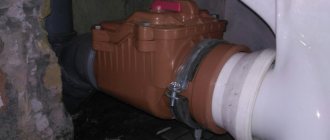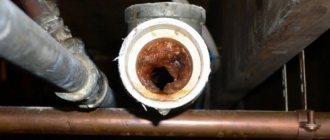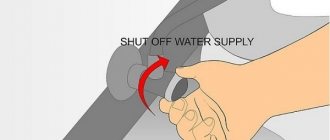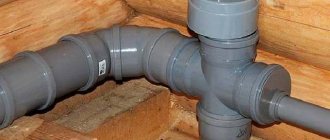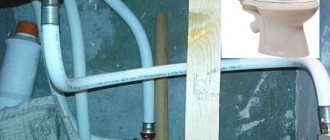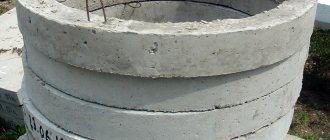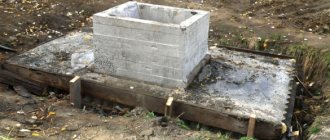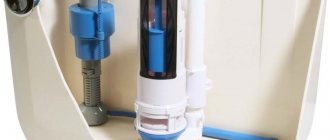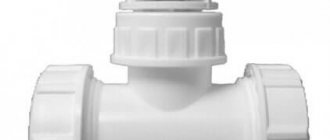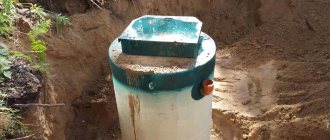A fairly new problem in the operation of sewer systems is the overflow of sewage. In most cases, such unpleasant moments happen to residents of the lower floors of multi-story buildings. Such “joy” can unpleasantly surprise literally instantly and cause considerable damage. Even if it is possible to avoid damage to furniture, then the need for repairs is an inevitable process. However, such situations also happen to owners of mansions (although much less frequently).
Of course, such a disaster does not happen in every apartment, however, if your neighbors are planning a renovation and start pouring the remaining solutions into the sewer, expect unpleasant news. Similar consequences can be caused by rags or plastic bags getting into the riser . The same phenomenon often occurs in old houses, but due to the banal wear and tear of the sewer system.
One way or another, the residents of the first two floors suffer. As a rule, the water column does not rise above the second one. However, if such a disaster occurs, it will take at least a long time to wait for the emergency team to arrive (which, to put it mildly, will not happen quickly) and for the happy moment when they discover and eliminate the cause of the blockage. During this time, with a high probability, the apartment may be completely flooded. Agree – it’s unpleasant. And don't forget that we are not talking about water.
Possible causes of sewer blockage
The occurrence of fecal backflow can be caused by several reasons. The first lies in the improper operation of the sewer system, where plastic bags, intimate hygiene products and other things that block the cross-section of the pipe may unintentionally end up.
Non-return valves make it possible to freely drain wastewater when the level in the drainage channel drops
In this case, you will need to think about how to break through the sewer at home. The most effective method is to use a cable to clean pipes.
During long-term operation, deposits appear on the inner walls of pipes, which gradually grow, reducing the clearance of the pipeline. The settled sediment forms a rough surface on which solid particles accumulate, resulting in the formation of a plug. A good result for removing blockages is the use of chemicals that dissolve deposits inside the drain.
Another possible cause of clogging of the sewer system is an incorrect slope of the collector, which occurs as a result of improperly performed installation work. Here it should be understood that a traffic jam can form both with a strong and with an insufficient slope. To prevent solid contaminated particles from accumulating on the inner walls of the pipeline, water must move through it at a certain speed. This problem can be eliminated only by completely reworking the system.
During long-term operation, deposits appear on the inner walls of pipes, which gradually grow
A common cause of clogged sewer drains is the presence of a large number of outlets located at an angle of 90°. This configuration of the system contributes to a sharp change in the speed of movement of wastewater. Large suspensions can immediately linger, forming a plug.
What is a check valve for sewerage 110 mm and other sizes
A check valve is a type of shut-off valve. It is installed in the lumen of the pipeline to block the reverse flow of liquid in case of clogging of the system. The device is installed in the basement on a horizontal section of the general sewer at the junction of the pipes. It can also be installed at a 90º turn in the pipeline.
To achieve maximum safety, a 50 mm sewer check valve can also be mounted on branches to plumbing fixtures on the first and second floors of an apartment building. This enhanced measure is justified by the fact that fecal water, when flowing back, can only rise above the first floor. Further, the accumulated mass is able to independently push through the plug formed in the pipe.
The check valve can be installed where the pipeline turns 90º
For the private sector, a check valve is installed before discharge into the sewer well (for each house separately - on the inside of the foundation). Such a device is also intended for an autonomous system, where wastewater accumulates in a drainage pit or in a septic tank. In this case, you should worry about how to fill the sewer cover with your own hands.
The check valve is characterized by simplicity of design, reliability, efficiency, durability, easy installation and convenient maintenance.
Valve Selection Tips
- To install the valve, before connecting the apartment sewer system to the common house sewer system, select a product for a non-pressure system.
- Any type of valve can be installed in front of the bathtub or sink. The main requirement for it is compliance with the fastening and diameter of suitable pipes.
- When installing the valve in a vertical riser, use a product with the appropriate mark on the packaging.
- Valve models designed only for vertical installation should not be used on horizontal sections of the pipeline, and vice versa.
- You cannot install a valve designed for pressure in a non-pressure system - it works with crushed waste materials and will quickly become clogged with waste from the toilet.
- To install a plastic valve on a pipeline made of cast iron or steel, special plastic adapters will be required.
- Models of products with flanges must be placed on pipes with the same type of fastening.
- It is not advisable to install metal valves on plastic pipes.
- The cost of check valves can vary by an order of magnitude. However, expensive models do not guarantee great advantages during operation.
Before purchasing
Before purchasing a check valve for the sewer system, you need to decide on the exact location of its installation and know the type of sewer system - free-flow or pressure (with a pump in the pipe system).
When choosing the required model, they also take into account the dimensions of the product, the manufacturer’s warranty period, build quality, complexity of the upcoming installation, material, functionality, and recommendations of practitioners.
Why do you need a non-return valve for a sewer?
The structure and principle of operation of a 110 mm sewer check valve
The check valve is compatible with all sewer pipelines of standard cross-section. Such safety fittings consist of a hexagonal housing, which can be made of metal or plastic. The internal space is conventionally divided into a receiving part with an inlet for connecting to the pipeline and a limiter in the form of a plate, which fixes the shut-off element and the outlet zone.
Important! The limiter is equipped with a sealing element that ensures maximum tightness when the valve is completely closed.
The check valve is characterized by simplicity of design, reliability, efficiency, durability
During normal fluid flow, the shut-off restrictor helps create full clearance in the pipe. If the water flows back, the shut-off element blocks it. Through the outlet zone, wastewater is discharged through the sewer line into the general system.
The operating principle of a 110 mm and other size sewer valve is as follows. At the moment the free movement of fecal matter stops, the pressure in the inlet and outlet zones of the valve is equalized. Under the influence of gravity, the limiter begins to block the gap in the pipe. This happens due to the expansion of the spring that is attached to it. In this position, it firmly holds the locking element. During normal operation of the system, the spring will be compressed.
Check valves are either mechanical or automatic. The operating principle of the devices is almost the same, except that the automatic device gives an alarm when an emergency occurs.
The check valve can be horizontal or vertical. The first option has become more widespread. A 110 mm vertical check valve is installed on the sewer system to automatically shut off the drainage system and to protect it in the event of a storm drain blockage. This element is used as a sewer inspection.
Check valves provide good protection against the penetration of unpleasant odors into the building.
Design of check valves for sewerage
Based on the design features of shut-off valves, a distinction is made between ball, rotary (petal), lift and wafer check valves. Despite the different designs of working areas, all types of devices have the same operating principle.
The ball check valve is equipped with a ball-shaped limiter. During normal operation of the system, the element is located in a special recess inside the housing, creating an open gap. As soon as the wastewater begins to move in the opposite direction, it blocks the cross-section of the pipe. This form of the locking element does not ensure the tightness of the valve as a result of the loose fit of the ball to the side walls. This may cause drainage to leak.
The wafer check valve has small dimensions. Its body looks like a hollow cylinder; inside there is a rotating bolt in the form of a small disk. It can be fixed on one side to the wall of the housing by means of a spring or have two flaps attached to a rod that passes through the center of the device.
The wafer check valve is small in size
Such a valve can be located on both horizontal and vertical sections of the pipe. When installing it, no additional gaskets are used, since the device is equipped with seals.
There are two types of 110 mm wafer check valve (and other sizes): disc and butterfly. In the first option, the locking element is made in the form of a solid disk fixed at the top of the body. Lowering under its own weight, it completely covers the cross-section of the pipe. This is the most reliable type of safety valve. However, it is used exclusively in a gravity system.
A double-leaf wafer valve has a central stem on which two petals are located. During the reverse movement of water, these flaps are pressed against each other by means of springs, blocking the cross-section of the pipe.
Features of Rotary Leaf and Lift Check Valve
In rotary reed valves, the working element is represented by a spring-loaded membrane resembling the shape of a round petal. When fecal matter flows freely through the sewer pipe, the plate is located in the upper part of the body in an inverted position, which does not interfere with the movement of liquid. If a reverse flow occurs, the membrane is pressed in the housing cavity against the rim, reliably and hermetically blocking the gap in the pipe. For inspection of the device, a removable cover is located in the upper part of the case.
The soft system is characterized by smooth movement of the petal locking mechanism
Important! There are check valves for a 110 mm pipe of the petal type with a manual shutter, which is a second plate, the operation of which is controlled using a button located on the body of the device.
Rotary valves can have a hard or soft system. In the first case, the disk covers the cross-section of the pipe under its own weight. This option is advisable to use for non-pressure systems with a small volume of wastewater. If it is installed on a pump or on a high-capacity network, the device can cause water hammer, which is a dangerous phenomenon for pipes. The soft system is characterized by smooth movement of the petal locking mechanism. In this case, water hammer is excluded.
The lift check valve has a shut-off element that is raised upward during normal operation of the system, which occurs due to the compression of the spring under the influence of gravity. When the liquid flows back, the spring expands and the lock closes the lumen of the pipe. This type of valve is more susceptible to clogging than others, which is due to the complex configuration of the body. It requires regular maintenance to function properly. This is the most common type of valve and is most often installed on the ground floor.
When fecal matter flows through the pipe, the plate is located in the upper part of the valve body in an inverted position
Principle of operation
An air drain valve is necessary in the system to equalize the rarefied (negative) pressure. It occurs when there is a sudden release of water in large quantities (flushing a toilet, pouring out a bucket of water, etc.), which carries with it a large amount of air. In normal condition, air is sucked in through the fan riser, the pressure stabilizes, and no unpleasant odors are observed.
But situations arise when the amount of air entering through the fan riser is not enough for the water to flow freely. That's when the smell appears. When there is a lack of air, the resulting negative pressure breaks the weakest water seal. This means that the water that stands in the elbow of the siphon (washbasin, sink, drain under the bathtub) is partially sucked into the sewer, allowing access to sewer gases. Until you use this device, air from the sewer enters the bathroom/toilet. This is not only unpleasant, but also dangerous. The sewer atmosphere contains not only methane, which in itself is not a gift. There may be bacteria, spores of various fungi, microorganisms.
Principle of operation
To prevent breakdowns of the water seal, an air valve is installed for the sewerage system. It has several other names - vacuum valve, sewer vent valve and aerator. In principle, it is the “aerator” that better reflects the purpose of this device, but this term is rarely used.
The operating principle of the air valve for sewerage is simple. There is a membrane that, under normal or positive system pressure, is adjacent to the valve body. In this position, the system is sealed, air from the sewer is blocked. When negative pressure occurs in the pipe (when water is drained), the membrane rises and air is sucked from the room into the sewer (not vice versa), quickly neutralizing the resulting difference. Everything happens at lightning speed, the water seals on the sanitary fixtures remain in place and continue to block the access of sewer gases to the premises.
There is also a sewer check valve. It solves the problem of reverse flow of drains when the risers are clogged. Read how to get rid of clogged pipes here.
Criteria for selecting a check valve for sewerage
Before purchasing a check valve, you should decide where exactly the fittings will be installed. The standard size of the product is selected in accordance with the diameter of the sewer pipeline.
For the manufacture of shut-off valves, the same material is used as for the production of the manifold. Here you should also pay attention to the quality of the device. Preference is given to a durable product made from a material that is resistant to negative consequences.
The device can be made of plastic, cast iron, steel or bronze. Plastic products are currently very popular, due to the installation of a drainage system made of plastic or polypropylene pipes. Metal products are most often used for external pipelines.
Helpful advice! For indoor installation, a gray plastic check valve is used, and for outdoor installation, an orange one is used.
The valve size is selected based on the diameter of the sewer pipeline
Check valves come in different diameters. For indoor systems, devices with a cross section of 50 mm are used. A 110 mm check valve is installed on the outlet pipe from the toilet. For external systems, devices with a diameter of 150 mm or more are used.
Helpful advice! If the valve and pipeline have different diameters, special adapters will be required when installing the device.
The valve must have a simple design, which ensures its easy, quick installation and convenient maintenance. For this purpose, it is recommended to choose models with a removable cover, which can be removed to clean the locking mechanism.
Related article:
Non-return valve for sewerage: protecting your home from flooding with sewageOperating principle and purpose of the device. Types of locking devices. Rules for selecting and installing a check valve.
A 110 mm sewer check valve can have one or two dampers. The second option is more reliable, since it is possible to close the device manually. This is a guarantee of reliable and durable operation of the mechanism.
How to install a check valve on a sewer pipe
There are two ways to install a check valve in a sewer system. The first involves installing a shut-off element on a common sewer in an apartment building. In the second case, the device is installed for each drain source. This option is used for private households.
The sewer check valve can be installed in two ways
Helpful advice! According to experts, installing one check valve measuring 110 mm for one riser is insufficient protection against possible flooding with wastewater, so it is recommended to additionally install shut-off devices on the first floors.
When installing the locking mechanism, it should be remembered that the valve is not mounted on the sewer pipe into the drain gap under the inspection cover. The dampers can operate effectively in a horizontal system. Otherwise, problems will arise with the drainage of wastewater, since the membrane in this position will not create their unimpeded movement.
When choosing a place to install a check valve, it is necessary to take into account that the device must be easily accessible so that in the event of an accident you do not have to dismantle the decoration or move furniture. A 110 mm sewer check valve is installed in the basement after the rotary elbow - before the pipeline enters the wall. In an apartment, the device is placed on a cross or tee near the central drain into the riser. If there is no technical possibility, then you can attach one shut-off element with a diameter of 50 mm to the outlet towards the bathtub or kitchen, and install a second valve with a size of 110 mm on the toilet.
Installing a 110 mm check valve for one riser is insufficient protection against flooding
The shut-off valves are mounted in such a position that it is possible to ensure free movement of flow in one direction. A hint is the indicator on the valve body, which indicates the direction of flow. It is necessary that the valve is at least 100 mm from the highest siphon.
Important! The check valve must not withstand compressive, tensile or torsional loads from the connected pipes.
The size and material of the valve must match the characteristics of the pipeline. Otherwise, you will have to use adapters, which will weaken the reliability of the system.
Types of valves and principle of operation
There are several types of sewer check valves of 110 and 50 millimeters, which differ in their scope of application. Accordingly, all types of mechanisms have a different design and operating principle of one element.
In general, all varieties have a single mechanism of operation of the system: in a quiet state, the blocking valve is located at the bottom, thus closing the lumen of the pipeline and preventing the reverse flow of liquid.
When the waste liquid approaches, the damper automatically rises, after which it returns to its original position. It is by the mechanism of operation of the damper that models of sewer check valves are classified.
Rotary
This type of sewer valve has a spring-loaded membrane (it is called a plate because of its round shape). When the wastewater moves in the right direction, the plate rotates and moves upward without impeding the movement of liquids.
However, when the drains are directed in the opposite direction, the spring-loaded membrane is pressed tightly against the outer rim, as a result of which the working area of the pipeline is blocked.
Some models additionally have a built-in additional damper, which is controlled manually. This locking mechanism can be adjusted using a special button located on the body of the device.
Due to the peculiarities of the design shape, this type of check valve for sewerage 50/110 mm is also called petal. As a rule, the device body is larger in size than the dimensions of the pipe where it is mounted.
Thus, the pipeline first has an expanding and then a narrowing section, which is a possible place for the formation of a blockage in the sewer system. The solution to this problem is to place the lid mechanism at the top of the housing. By removing it, you can easily and quickly remove the clog that appears.
Lift valve for sewerage
The name of this type of device is based on the mechanism of the damper.
When wastewater moves in the correct direction, the flapper is positioned at the top. Operating principle: the liquid exerts pressure on the membrane, which blocks the movement of waste, the internal spring is compressed, as a result of which the damper rises. If the wastewater does not move, then the spring is in its normal state, and the path of the wastewater is blocked.
Due to the nonlinear body shape, when the fluid moves in the opposite direction, opening the valve is impossible, which ensures complete safety from flooding.
This type of check valve for sewage 110 or 50 mm has greater operational reliability than the rotary (petal) model, but there is also a drawback.
The shape features make it necessary to regularly clean the system, because... it gets clogged periodically. To perform this procedure, you will need to unscrew the bolts (4 pcs.), then thoroughly clean or, if such a need arises, replace the working mechanism. If the owner has the opportunity to carry out regular cleaning, then it is better to purchase a similar version of the check valve.
Ball valve
In this type of device, the locking element is a small ball. The upper part of the body is designed in such a way that when wastewater flows, the ball falls into a separate hole and allows the flow to move.
When there is no fluid present, the working area of the pipe is blocked, preventing flow from flowing in the wrong direction. However, such models have a drawback - unlike the rotating and lifting mechanism, in this design the ball valve does not completely adhere to the rim of the device.
As a result of a leak, a small amount of waste water may leak. Of course, the likelihood of severe flooding, as if the sewer check valve were missing entirely, is minimal.
Wafer
The main advantage of this type of locking mechanism is its small dimensions, which makes installation possible even if there is no free space behind the plumbing fixtures. Externally, the device looks like a miniature cylinder with a special rotary valve.
This element can consist of 2 components that are fixed to the central rod, or in appearance it can resemble a small plate that is fixed to the body using a spring mechanism.
It is advisable to install this option only if other varieties cannot be installed. Even taking into account the small size, it is still advisable to give preference to other types of devices. A 50 mm wafer check valve for sewerage is installed quite rarely, because... belongs to the category of water supply equipment. For sewer systems, its efficiency is quite low.
Another disadvantage of this design is the inability to quickly clean the device. Due to its shape, the connection will need to be completely disassembled to clean the valve.
Installation of 110 mm check valves made of different materials on the sewer system
Currently, as evidenced by reviews from owners, a 110 mm sewer check valve is most often chosen in a plastic version. This is due to the fact that the drainage system is mounted from this material. Installation of the product does not cause any difficulties.
Check valves for sewerage are most often made of plastic.
Once the location for installing the valve has been selected, a section of the pipeline should be cut, the length of which must match the dimensions of the shut-off device with an allowance of 5 cm. The pipe sections must be processed with a file. A valve with a socket connection is placed on a section of pipeline. The same procedure is performed on the exhaust manifold side. The connection is sealed using sealing elements of the locking device.
Helpful advice! To ensure the most reliable connection, the edges of the pipes are recommended to be treated with sealant before installation in the socket.
When using a plastic check valve for a 110 mm sewer pipe for a cast iron or steel pipe, you must additionally purchase two adapters. The sequence of work is the same as when installing a shut-off element on plastic pipes. Using a grinder, a space is cut out on the manifold for mounting the locking element. The edges are processed with a sanding machine.
An adapter is put on a piece of pipe, then a check valve, after that another adapter, which is attached at the other end to the pipe by means of a socket connection using tow. To make the system reliable, the seams are treated with silicone.
Check valves can be made of cast iron and steel
Important! The cast iron check valve is mounted using bolted joints by tightening the mounting plates and sealing rubber bands.
Why is a 110mm air check valve used?
To eliminate the possibility of wastewater entering the room, an air valve is mounted on the drain pipe, which allows air into the system and prevents it from coming out back. Such a shut-off element also helps to reduce the noise level in the system when the waste stream moves.
When water is drained, a vacuum occurs in the sewer system, causing air to enter it. This is accomplished due to the presence of ventilation or plumbing fixtures that have the smallest water seal. As a result of the vacuum, the membrane opens, and after the pressure stabilizes, it closes, which prevents the flow of air back into the room.
The air check valve for sewerage is made of high quality plastic. The element consists of a body, a membrane or rod, a rubber seal and a cover. The membrane reacts to excess pressure in the network and is activated when it occurs. The operating mode of the rod is controlled by the sealing gasket. The element is connected to the pipeline through a side hole.
Fan valve 110 mm is fixed only in a vertical position
A 110 mm vent valve for sewerage, like a return valve, is installed no higher than the 2nd floor. It should be located above the largest sewer pipe connected to the device. The valve is fixed in a vertical position. It is mounted to the pipeline using a socket connection, complete sealing of which is ensured using rubber cuffs treated with silicone.
Important! The air valve is installed in a place where the temperature will not drop below 0 °C.
The locking element can be automatic, anti-vacuum or a combination. The first type of product has a low throughput. The second valve option works well at low pressure. The combined version combines the features of both types of devices.
Where to put
When installing, the air valve for the sewer must be placed 20-30 cm above the axis of the main sewer pipe. In two and three-story private houses, the device is installed on the top floor.
It must be installed in a place where splashes or dirt will not get on the membrane. The performance of the device depends on how clean the membrane is. Salt, grains of sand, pieces of garbage, etc. will appear on it, it will not be hermetically pressed against the body, and a stench will begin to seep into the room. By the way, if you observe this, clean or change the membrane for now.
You need to find a place so that air can flow freely to the membrane. This is the basic condition for normal operation. When 1 liter of water falls down the drain, it can carry 25 liters of air with it. Therefore, air access must be free.
If you decide to install a ventilation valve on the sewer, you need to know that sometimes during operation it can make “grunting” sounds - the membrane sucks in air when a slight vacuum occurs in the pipe. Not all models behave this way, but there are such complaints. So it’s better to find a place where these sounds (if any) will not interfere.
Installing a shower cabin with your own hands is described here.
In apartments
If we are talking about an apartment in a multi-story building, then you can install an air valve on any vertical section of the pipeline. To do this, you can build a tee into the system, install a pipe vertically upward into it, and place a ventilation sewer valve on it. This will not solve the problem of ventilation of the entire riser globally, but your particular site will work without problems.
It is advisable to place it above the main sewer pipe
In a private house
If we are talking about a private house, then most often they want to install an air valve for the sewer system so as not to remove the drain pipe through the roof. The correct passage of a pipe through the roof is a complex matter, and it is not easy to achieve its tightness. This is often the reason why people don't want to make holes in their roofs. Many people also don’t like pipes sticking out above the house. In principle, you can take the ventilation pipe into the attic and place a sewer ventilation valve on top. In this case, the riser will be unventilated. But this is far from the best solution. At least that's what the plumbers say. They argue that for normal operation of a septic tank, ventilation is needed to provide bacteria with oxygen.
If your wastewater treatment takes place in a septic tank, you cannot do without a drain riser; you will have to remove it through the roof. If hydraulic valves fail periodically, it will be possible to install an air valve for the sewerage system as an additional element of the system - on the highest floor (it does not need to be installed in the attic).
If you have an autonomous sewage system based on autonomous treatment stations, you can try to make it unventilated - put the pipe into the attic, and put a vacuum valve on top of it. The attic must be unused, of large volume, with good ventilation. The smell will be present and it will need to be removed outside somehow. If the attic is cold, the pipe must be insulated (but not the valve).
Where to install an air valve for sewerage in a private house
And all the same, plumbers and designers insist that in private houses an air valve for the sewer system should be installed only as an addition to the drain riser.
